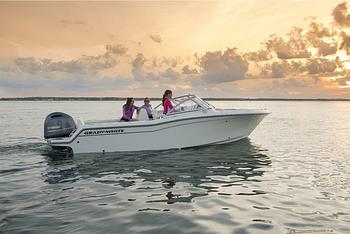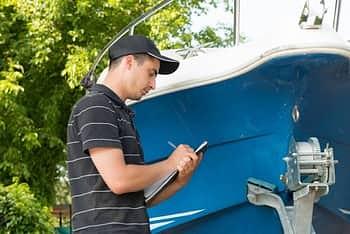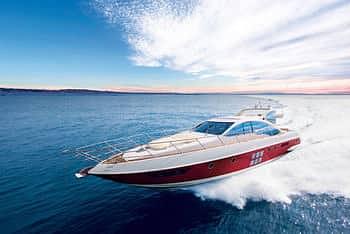We hear the question “Do I need a sea trial?” more often that you might think, especially given that the obvious answer is yes. Of course, you can buy anything—a boat, a car, a snowmobile, or you name it—without a trial run, but it adds an element of risk to your purchase. A sea trial test is your way to get a feeling for the boat and to find out more about the way it maneuvers and discover any issues that might arise. Speaking of discovery, taking a boat out for a sea trial will almost always teach you things you didn’t expect to learn and raise questions that you hadn’t thought of asking—so don’t miss it if there’s any way you can arrange a sea trial. And once you have one scheduled, keep in mind that a sea trial is not a pleasure cruise; leave the kids and extended family at home so you can be focused on the job at hand. Now let’s take look at everything you need to know about boat sea trials.

Taking a boat out for a sea trial will almost always teach you things you didn’t expect to learn and raise questions that you hadn’t thought of asking.
What is a Sea Trial?
A sea trial is essentially a test drive of a boat. It gives you, as the prospective buyer, the chance to see the boat in action, to try out all the equipment and instruments, to get a feel for the boats’ maneuverability at higher and lower speeds—underway and at the docks—and often to take along a surveyor. In fact a sea trial is often conducted on the same day as a marine survey for that reason, and the surveyor will include the sea trial as part of their report. Having said that, you don’t have to take along a marine surveyor for a sea trial and there is much that you can inspect yourself.
Do I Need a Sea Trial for New Boats or Just Used Boats?
Sea trials are important for both new and used boats, as it’s the only chance you’ll get to feel the boat in the water and understand how it moves under way. A sea trial for a new boat is a much simpler process as a warranty would cover anything that might go wrong down the line, but it also often provides you with a chance to learn more from the boat dealer or sales representative. Unlike aboard a used boat, you’re less likely to be looking for mechanical issues and will instead simply learn more about and get a feel for the layout, instruments, and ride. A sea trial on a used boat will be a more thorough affair and help you discover any issues that there might be, and it may well leave you with more questions than answers.
How Much Does a Sea Trial Cost?
A sea trial on a used boat is usually conducted as part of a marine survey and therefore the price will be incorporated into the overall inspection and report. A seller wouldn’t normally charge a prospective buyer for a sea trial, even if a surveyor isn’t taken along, as this is a part of the sales process.
Sea Trial Checklist
While it’s common to take along an experienced marine surveyor on a sea trial, it’s good to have your own checklist of things to test or try out as both driver and passenger. Be prepared and make a list of everything you want to check and take it along with you. The following points will give you a starter list; keep in mind most are relevant for both new and used boats, as even a new boat may have its quirks.
-
On the water, take the wheel to get a true feel for the boat. As driver, you’ll want to try all controls and instruments, check the visibility and comfort in the helm position, and note sight lines both at slower speeds and again when planing.
-
Mechanically, how does the throttle and gear shift work, and what does it sound like when putting the engine in gear?
-
Don’t forget to put the boat in reverse, as well, checking visibility and noting how the boat tracks or wanders.
-
At low speeds, test the effectiveness of any bow and stern thrusters the boat may have.
-
Observe fore-and-aft trim of the hull and how it adjusts with trim tabs or engine trim.
-
Acceleration! If planning to use your boat for watersports you’ll need enough power to tow any riders, so give it full throttle and see what it can do from zero to max speed.
-
Test how the boat carves through the water at a fast cruising speed (which will vary depending on the type of boat). On a planing powerboat, it should ideally move smoothly through a turn and without losing power as you crank hard over to each side.
-
When trialing a boat, it will likely only have a few people aboard. If you plan to carry a crowd in the future, consider the power of the engines. If the boat is sluggish with a light passenger load, they won’t perform any better with more weight.
-
Try to find rougher water, or cross several wakes from other boats, to see how the boat handles. Slow down to an idle and note how the boat rolls in the waves as well. You’re looking for a smooth and level ride for the conditions.
-
Listen for any rattles or vibrations and report them to the marine surveyor if you have one aboard. While they will be performing their own series of checks, it’s your purchase, so you should mention anything that concerns you.
-
Switch on and test the following, and also note any aging equipment that might be a candidate for replacement:
-
Batteries & charging systems
-
Navigation lights & any interior lights
-
Navigation equipment
-
Stabilizer system
-
Windlass
-
Generator
-
Bilge pumps
-
Fuel & other gauges
-
-
If conducting a sea trial on a sailboat, you’ll want to hoist all the sails and get a feel for how the boat performs. Check the condition of all the sails, and ask about spare sails that may be available with the purchase.

While it’s common to take along an experienced marine surveyor on a sea trial, be prepared and make a list of everything you want to check and take it along with you.
Who Steers During a Sea Trial?
Providing you have the necessary certifications for your country, then it’s important that you ask the seller to allow you to drive the boat. You won’t be able to get a good feel for it if you don’t take control of the helm and do your own maneuvering.
Then again, don’t spend all of your time at the helm. You’ll also want to act as passenger for some of the time, too, and perform a different series of checks, all the while taking notes: How loud is the engine? How roomy are the decks? How many people could you comfortably get on board? How comfortable are the cushions and seating areas? If there’s a galley, then how well equipped is it? If there are cabins how comfortable are the beds and what is the storage like? Speaking of storage, make sure to open every cupboard and locker and see what’s inside and how much space you may have. If you’ll be using your boat for overnight trips or longer, you’ll need plenty of storage space.
How Long Does a Sea Trial Last?
This isn’t a pleasure cruise, so be respectful of the broker or owner’s time and fuel, and we recommend keeping it to about an hour. Your marine surveyor may need more or less time depending on the type of the boat and the size of it, but your checks should be easily completed in this time frame. Having said that, if you need to travel a little farther to find some rough water or a good place to practice low-speed maneuvers, don’t hesitate to ask for the extra time.
Check Safety Equipment First
Check to make sure that there are basic boat safety equipment items aboard before setting off on the sea trial (or on any boat for that matter). Ask the broker or owner to show you where the fire extinguishers and life jackets are, and make sure there is enough fuel on board and the radio works. Bringing along your own handheld VHF is always a good idea.
Enjoy the Experience
While the main objective of a sea trial is to check all of a boat’s systems and how it runs, that doesn’t mean you can’t enjoy yourself. Buying a boat is a big undertaking, but it’s also a wonderful step towards a new lifestyle. Imagine how you would use the boat and enjoy it, how you would spend days on the water with family and friends, fishing, swimming, watersports or even sailing around the world.
If you have more questions about the boat-buying process, read “How to Buy a Boat: The Ultimate Guide,” or visit the rest of the articles we have on buying a boat in our blog.
This article was published in July 2022 and updated in November 2023.
Related Articles and Guides
7th Jun 2024
Best Boat Brands for Beginners: Power, Sail, Pontoon & Fish
25th May 2024
Boat Inspection Checklist: How to Inspect a Boat Before Buying
4th May 2024
Do You Need a License to Sail a Boat in the US?
1st Nov 2023







